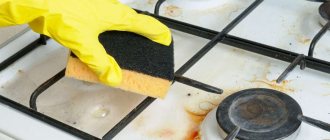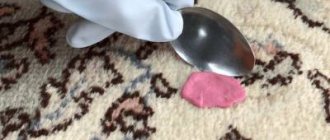Method 6
Soak a cotton pad in acetone or vinegar and rub the working surface of the iron. After removing carbon deposits from the iron, wipe it with a piece of wool. If the carbon deposits have not gone away, then turn off the iron, let it cool slightly and place it overnight on a rag soaked in vinegar. The plaque will soften, peel off and can be removed with a soft cloth.
Preventive measures
It would be useful to remind you how to prevent the formation of soot. The recommendations are obvious, but for some reason many people ignore them.
- Always follow the ironing temperatures indicated on the clothing label. This is especially true for synthetic and delicate fabrics. If for some reason the label has not been preserved, then there are hints on the iron mode switch.
- Iron thin materials, wool and silk through damp gauze.
- Never iron already worn, unwashed items. Dirt particles stick to the base and damage it.
- After ironing, wipe the surface with a cloth soaked in a weak solution of citric acid.
Method 7
In hardware stores you can purchase a special pencil for cleaning the iron from carbon deposits. To use it, you need to heat the iron and rub it with a pencil. Then wipe the sole with a cloth. If you have chosen a high-quality pencil, then after cleaning the iron will become like new, smoother and more gliding. The above methods will help you quickly remove carbon deposits from your iron at home. They are also suitable for cleaning Teflon irons. However, for such delicate and sensitive units there is another, more gentle method.
Material
Even when choosing an iron, you probably noticed that its sole can be made of different materials. We will not analyze the characteristics of each type, but will look at them from the point of view of the complexity of care and cleaning.
In any case, it is better to avoid coarse abrasives. For devices made of aluminum and stainless steel, exposure to small particles is still possible in exceptional cases (although they can leave unsightly scratches), but their use on ceramic and Teflon devices is absolutely unacceptable. Scratches can disrupt the operation of the unit and it will no longer perform its function well.
Therefore, first of all, try soft liquid formulations, and only if they do not help, use heavy artillery.
Method 10
You can also use baking soda. You need to mix it with water, soak a cotton pad in the solution and rub the cold iron in a circular motion. After this, rinse the surface of the iron with a sponge soaked in clean water and wipe with a soft cloth.
It is important to remember that you should never clean your iron with rough abrasives or a knife. This damages the working surface of the iron and can lead to further problems.
Everyone also knows that prevention is better than cure. Therefore, after each use of the iron, wipe its sole with a soft cloth.
Source: masterlomaster.samodelkinoblog.com
How to descale your iron
If the steam function begins to work poorly, and the iron leaves red spots on clothes, most likely scale has formed in it. Three win-win recipes will help you remove it without leaving a trace.
Method 1: Self-cleaning function
In many modern models, the manufacturer took care of the scale problem. If you are not sure of the purpose of some of the buttons on your unit, check the instructions: you may be the happy owner of an iron with a self-cleaning function. To carry it out, carefully follow the manufacturer's recommendations. In short, the algorithm is as follows:
- The maximum possible amount of water is poured into the tank.
- The temperature regulator is set to maximum.
- The device heats up, cools down, heats up again.
- The iron is tilted over a bowl or sink.
- After pressing the self-cleaning button, scale is removed from the steam holes on the soleplate.
After the procedure, rinse the tank with clean water several times and wipe the iron dry.
Method 2. Citric acid
Dissolve a tablespoon (20–30 grams) of citric acid in a glass of water and pour into the reservoir. Heat the iron to maximum, shake well several times and press the steam release button. Carry out this procedure over a sink or container: the scale will come out along with the steam in hot dark sprays. Afterwards, rinse the tank with clean water and wipe the soleplate of the iron to remove any remaining dirt.
Method 3. Carbonated mineral water
Carbonated drinks contain acids that will help dissolve the sediment inside the iron. Just pour the mineral water into the tank and follow the instructions in the previous paragraph.
Causes
Modern irons have long been produced with a built-in steam generator, which is very convenient. Ironing has become easier, faster and simpler. A steam generator is a small tank filled with water. As the temperature rises, the liquid evaporates and is supplied through a valve system to the soleplate of the iron.
When everything works correctly, the required amount of steam is supplied to the fabric, which evaporates almost instantly. The water is clean, transparent, odorless, but if it changes color, it means there is a breakdown. There are two main reasons why brown sticky liquid comes out of the holes: rust or decomposition of the silicone parts of the iron.
Iron with built-in steam generator
Rust
The most common cause of rusty water. Rust accumulates in the internal tank of the steam generator as quickly as scale. This happens when there is no insulation on the metal elements. If rust has accumulated inside a metal sole, it will come out along with water and steam, staining your clothes.
Important! If the parts are completely rusted from the inside, the device cannot be repaired; it is easier to replace it with a new one.
Decomposition of silicone elements
If your iron leaks when ironing, it may be due to damage to the silicone parts. This is a gasket located between the steam generator and the metal base. If the thermostat does not work well, the device does not have time to cool down.
During operation, the temperature of the sole can reach +300 degrees; even heat-resistant plastic will sooner or later begin to melt. It is at this moment that not only a thick brown slurry is formed that drips from the holes of the iron, but also an unpleasant odor.
Important! If there is a smell of burnt sugar while ironing clothes, you need to take the appliance in for repair.
If the silicone inside has melted, you should never use cleaning agents. Only replacing or repairing the thermostat will help get rid of the problem.
Improper cleaning with anti-scale agents also leads to brown stains. If the silicone has melted, the acidic compounds recommended for washing will corrode the plastic.
The decomposition of silicone elements inside the iron is the cause of rusty water
What and how to wash the inside at home?
During the steaming process, water boils in the iron tank and, as a result, a coating of hardness salts (calcium and magnesium) forms on the heating element.
During operation of the device, sediment gradually accumulates and turns into hard scale , which interferes with the normal functioning of the device.
IMPORTANT! At the first signs of plaque and for preventive purposes, clean the electrical device once every 3-4 months.
This is interesting: 8 recipes for delicate cleaning of a Teflon iron.
Have you ever descaled your iron?
Not really
On a note
Clean the iron outside and inside at least once every six months:
- Scale, mold - from the water tank;
- dust and dirt - from the body;
- traces of burnt fabric, rust and scale from the sole.
Cleaning your iron with vinegar is quite simple. The majority of device models will not be damaged by using the product, since it does not contain abrasive particles. It is important to keep in mind that the iron platform and the steam that is generated during heating cause severe burns. So be careful.
* Do you have your own secrets for cleaning household appliances? Share them in the comments!
Types of soles and features of their cleaning
The cleaning method depends on the material from which the sole is made:
- Ceramics. Even minor damage can lead to peeling of the enamel, so you can clean such a surface with soft, non-abrasive agents and sponges. It is better to choose liquid formulations.
- Stainless steel. The material is very durable, so it can be cleaned by any means, including cleaning with abrasives.
- Titanium. The material is stronger than steel: it can be cleaned by any means. If the deposit is old and persistent, even a soft sponge made of metal wire will do.
- Aluminum. These soles are practical and inexpensive, but soft metal is easy to scratch. It is recommended to clean with mild cleaning agents, such as vinegar.
- Teflon. This material protects the metal sole of the iron from carbon deposits and rust, but it is very fragile and prone to scratches. Therefore, you need to handle Teflon carefully, using only liquid compounds for cleaning.
- Enamel. Easy to clean with a cloth soaked in water or a solution of laundry soap. If persistent carbon deposits form, it is permissible to use a soft metal sponge or a wooden spatula. You can use any home or store-bought products.
Recipe 1: Clean the soleplate of the iron with salt
How to clean the soleplate of an iron with salt?
Ingredients:
- Salt.
- A blank sheet of paper or cardboard.
How to clean the soleplate of your iron with salt:
- Spread the salt in one layer on a clean sheet of paper or cardboard.
- Split the iron.
- Run the iron over the salt scattered on the sheet, pressing the soleplate firmly. The salt will remove all the carbon deposits from the surface.
Important! Please note that this recipe is not suitable if you need to clean the soleplate of a Teflon iron. Because Coarse salt can scratch it.
Cleaning the safety valve or anti-lime rod
To combat contamination of the interior, anti-lime rods are used. They are designed for water filtration. The mechanism for using such rods is as follows.
- It is located in the hole designed to supply steam to operate the iron.
- The rod is not inserted tightly, water flows, contaminating it.
- No replacement is required, but cleaning must be done periodically. It is performed monthly by removing the part and placing it in a special composition that contains 1 part water and 1 part vinegar, soda or citric acid.
- The duration of the cleaning procedure is 120 minutes. As a result, contaminants are completely dissolved.
- After finishing cleaning, rinse it with water, dry it and put it back in place.
Prevention
An effective way is to use special cassettes, which are used to pre-treat the water. They are designed to make it softer and cleaner. This cannot completely eliminate the occurrence of scale, but it can significantly slow down this process.
Another method of prevention is the use of anti-lime rods. They are located inside the tank and during operation they collect most of the contaminants on their surface.
It is recommended to use clean water for ironing, which should be drained after finishing using the iron.
You can quickly clean your iron with a steamer. But do not forget that you must follow all recommendations, otherwise you can damage the device.











